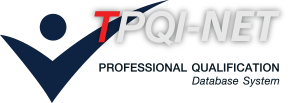หน่วยสมรรถนะ
Inspect and maintain structures and related components of non-pressurized.
สาขาวิชาชีพการบิน
รายละเอียดหน่วยสมรรถนะ
| 1. รหัสหน่วยสมรรถนะ | AVT-BPQI-217A |
| 2. ชื่อหน่วยสมรรถนะ | Inspect and maintain structures and related components of non-pressurized. |
| 3. ทบทวนครั้งที่ | / |
| 4. สร้างใหม่ |
|
ปรับปรุง |
|
| 5. สำหรับชื่ออาชีพและรหัสอาชีพ (Occupational Classification) | |
|
7232 Aircraft engine mechanics and fitters |
|
| 6. คำอธิบายหน่วยสมรรถนะ (Description of Unit of Competency) | |
| This unit competition requires the application of procedures and techniques related to the inspection and maintenance of small structures unpressurized aircraft during scheduled or unscheduled maintenance, including required special inspections after events such as landings, an overload or a flight through heavy turbulence. The unit also includes performing a limited number of minor repairs metals and compounds minor classified as elementary maintenance. application procedures is also required and techniques associated with the removal and installation of structural and nonstructural components related, including elements such as internal adjustment, seats and emergency equipment. The work can be done individually or as part of a team. | |
| 7. สำหรับระดับคุณวุฒิ |
| 1 | 2 | 3 | 4 | 5 | 6 | 7 | 8 |
|---|---|---|---|---|---|---|---|
| 8. กลุ่มอาชีพ (Sector) | |
| 10 Aircraft Mechanics | |
| 9. ชื่ออาชีพและรหัสอาชีพอื่นที่หน่วยสมรรถนะนี้สามารถใช้ได้ (ถ้ามี) | |
| 101 Aircraft Maintenance: Airplane102 Aircraft Maintenance:Helicopter103 Aircraft Maintenance: Avionic | |
| 10. ข้อกำหนดหรือกฎระเบียบที่เกี่ยวข้อง (Licensing or Regulation Related) (ถ้ามี) | |
| ICAO Doc 7192 / EASA Part 66 | |
| 11. สมรรถนะย่อยและเกณฑ์การปฏิบัติงาน (Elements and Performance Criteria) |
| หน่วยสมรรถนะย่อย (EOC) | เกณฑ์ในการปฏิบัติงาน (Performance Criteria) | รหัส PC (ตามเล่มมาตรฐาน) |
รหัส PC (จากระบบ) |
|---|---|---|---|
| 101320.01 Inspect and maintain aircraft structure. |
101320.01.01 Aircraft structure visually or physically checked for signs of defects of deformation or damage in accordance with maintenance documentation and procedures approved, while observing all requirements of relevant occupational health and safety (WHS), including the use of safety data sheets (MSDS) and items of personal protective equipment (PPE), and damage or defects are assessed against damage or wear limits specified by structural repair manual or other approved data to determine if repair or replacement is required. |
101320.01.01 | 199301 |
| 101320.01 Inspect and maintain aircraft structure. |
101320.01.02 Preventative maintenance techniques are employed to preserve the integrity of aircraft structure, and required maintenance documentation is completed and processed in accordance with standard enterprise procedures. |
101320.01.02 | 199302 |
| 101320.02 Prepare and Install components. |
101320.02.01 Structure is supported and prepared in accordance with the applicable maintenance manual to ensure the safety of personnel and the absence of damage to the aircraft or component during removal of components. |
101320.02.01 | 199303 |
| 101320.02 Prepare and Install components. |
101320.02.02 Component extraction is carried out in accordance with the maintenance manual applicable to observe all relevant requirements of the WHS, including the use of MSDS and PPE items. |
101320.02.02 | 199304 |
| 101320.02 Prepare and Install components. |
101320.02.03 Support/safety equipment is removed at an appropriate time to ensure personnel safety and freedom from structural damage. |
101320.02.03 | 199305 |
| 12. ความรู้และทักษะก่อนหน้าที่จำเป็น (Pre-requisite Skill & Knowledge) | |
|
101301 Interpret work health and safety practices in aviation maintenance. |
|
| 13. ทักษะและความรู้ที่ต้องการ (Required Skills and Knowledge) | |
|
(ก) ความต้องการด้านทักษะ See Appendix A (ข) ความต้องการด้านความรู้ See Appendix A |
|
| 14. หลักฐานที่ต้องการ (Evidence Guide) | |
|
(a) Performance Evidence It is essential that the procedures take account of all aircraft and personal safety precautions related to the airframe. Evidence of transferability of skills and knowledge related to the inspection, testing and minor minor repairs to the aircraft structure, except primary structure is essential. (c) Assessment recommendation N/A |
|
| 15. ขอบเขต (Range Statement) | |||||||||||||||||||||||||||||||
|
(a) Recommendation
(b) Description |
|||||||||||||||||||||||||||||||
| 16. หน่วยสมรรถนะร่วม (ถ้ามี) | |
| N/A | |
| 17. อุตสาหกรรมร่วม/กลุ่มอาชีพร่วม (ถ้ามี) | |
| N/A | |
| 18. รายละเอียดกระบวนการและวิธีการประเมิน (Assessment Description and Procedure) | |
|
The assessment are based on combination of paper exams, interviewing, and practical demonstrations depending on the assessors’ judgement. Competition should be assessed in the workplace or work environment simulated using tools and equipment specified in the maintenance documentation. It is also expected that the general purpose tools and test equipment found in most routine situations would be used where appropriate. |
|
